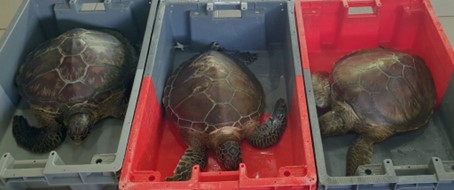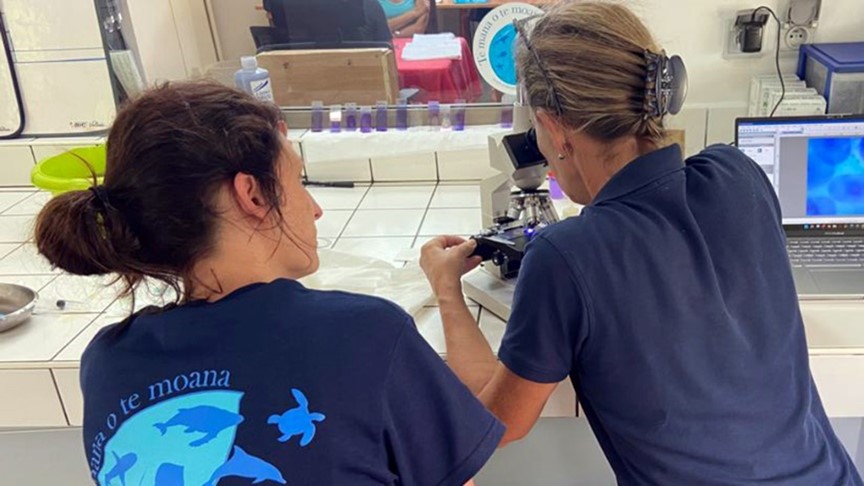March 2022

I got the chance to be invited as a consultant by Dr. Cécile Gaspar, CEO and co-founder of the NGO « Te Mana O Te Moana ». This NGO aims at treating sick or injured sea turtles as well as educating new generation and general public to better protect the ocean and better understand the environmental challenges the ocean is facing.
https://www.temanaotemoana.org/fr/
I was invited in Moorea to help with diagnostics of several cases of "floater syndrome".
https://fovea-vet.fr/consulting-en-polynesie-francaise/
This was a fantastic human experience, sharing and setting up protocols to help improve diagnostics.
Sea turtles suffering from buoyancy disorder are not considered releasable as they are unable to submerge and can be easily captured. Indeed, they won't be able to forage appropriately and are at risk for watercraft collision or fishing gear entanglement.
Basically, 4 causes are responsible for this floating disorder and clinical workup starts with a good clinical examination, blood work (biochemistry and hematology) as well as radiographs. In some cases, a CT scan or MRI may be recommended.
- Intestinal gas:
- Ileus= Decrease in peristalsis, which may be due to intestinal atony related to infection or dehydration, loss of neurologic function and subsequent paralysis, or bowel obstruction.
- Bowel obstruction can result in mechanical ileus (can be due to foreign body such as plastic, fishing line), intussusception or constipation/obstipation.
- Intestinal gas can vary in location and can change location.
- Pulmonary:
- Air may be trapped in bulla in the lung
- Aspiration pneumonia typically bilateral.
- Pneumonia usually lateralizes
- Pneumocoelom(free gas in the body cavity): usually central
- Associated with trauma that can result in lung tears.
- The presence of free gas in the coelom will create positive pressure and compress other viscera including the lungs.
- Many small lung tears will spontaneously seal. Daily aspiration of free gas (measure and record the volume) can promote sealing of small tears
- Neurologic: following trauma and infectious/inflammatory process
- Internal tumors, such as fibropapillomas
- Can cause lateralizing, nonshifting buoyancy issues.
Chronic buoyancy (> 4 weeks) will result in changes in conformation of the lungs as the saccular lungs expand. A chronic posterior buoyancy will caudally dilate the lung fields. Lateralizing buoyancy problems can result in hyperinflation and enlargement of one lung with hypoplasia of the other.
Once these conformational changes occur the animal may remain positively buoyant even if the original cause has been corrected
If the animal is to be held in captivity and the buoyancy problem has not resolved in 1 month then external weights should be applied to normalize flotation and prevent deformation of the lungs.
Diagnostic/therapeutic coelomocenteis may be performed as both a therapeutic and diagnostic tool. If free air is encountered them continue to draw until negative pressure is encountered.



November 2021
https://observatoire-tortues-marines.mnhn.fr/
November 20-21st 2021 : Formation vétérinaire au Marineland d'Antibes
In 2020, an online training via videoconference that lasted 2 days was taught by Dr. Estelle ROUSSELET. This training encompasses physical examination, basic anatomy and physiology of sea turtles as well as medical treatment of common presentations, surgical approaches and additional diagnostic tools (ultrasonography, radiography and endoscopy). This training was performed within the scientific program of the l'Observatoire des Tortues Marines (OTM). It was organized by the Muséum National d'Histoire Naturelle (MNHN) and funded by the Ministère de la Transition Ecologique in collaboration with the group « Pathologie et centres de soins » GTMF TOTM (French Sea turtle network Groupe Tortues Marines France).
A year later, Marineland (in Antibes, France) hosted the first practical training dedicated to veterinarians and managers responsible for rehabilitation centers part of the French Sea turtle network (GTMF-TOTM). Forty professionals from France and overseas were able to optimize their technical skills. This first-time event was co-organized by the Muséum National d'Histoire Naturelle (MNHN), PatriNat, Marineland, in collaboration with the groupe Pathologie et Centres de soins GTMF-TOTM.
Experts are now on ready to collect more data that will improve the ability to perform health assessment at the population level with the goal of measuring anthropogenic impacts on these endangered species.
The training lasted 2 days: practical skills were demonstrated from clinical examination, blood draw including cytological evaluation, ultrasonography and radiograph positioning. Then, anesthesia protocols and triage process were discussed, including admission of cold-stunned and debilitated animals.
This event was also available via videoconference for members of the Groupe Tortues Marines France (GTMF) living abroad (Martinica, La Réunion's island, French Polynesia, Saint-Pierre et Miquelon).
Finally, a wet lab was undertaken at the laboratoire vétérinaire départemental (LVD) de Sophia-Antipolis, which included a full necropsy with lesion description and sample collection.
The session concluded by visiting the Centre de Réhabilitation de la Faune Sauvage de l'Association Marineland, hosted at Espace Mer et Littoral in Antibes.
Testimonies and explanations can be found below and belong to the Marineland (https://www.marineland.fr/blog/les-tortues-marines-a-lhonneur).

Des experts venus du bout du monde pour l'occasion
Pour le Dr Estelle Rousselet (DVM, PhD, diplômée de l'American College of Zoological Medicine) qui a animé de nombreux temps forts : « Cette formation est la première en son genre. Elle a permis de former bien sûr mais aussi d'échanger et de partager des compétences portant sur la médecine des tortues marines. Nous avons pu associer des vétérinaires, des biologistes et des directeurs de centres de soins, avec un souci d'harmonisation des pratiques et au final de promotion du bien-être animal ».
Pour Françoise Claro, coordinatrice du Groupe Tortues Marines France pour le MNHN : « Ce week-end de formation a été un moment vraiment unique pour perfectionner les techniques d'intervention des vétérinaires et responsables de réseaux et centres de soins. Gageons que cela permette d'augmenter les chances de survie des tortues marines, espèces protégées en France et souvent lourdement impactées par les activités humaines ».
«Cette formation a été une vraie réussite ! » renchérit Sidonie Catteau, capacitaire tortues marines et responsable du Centre de soins de l'Association Marineland, « Ces spécialistes sont venus de Polynésie, de La Réunion, de la Martinique, de la Nouvelle Calédonie, de Saint-Pierre-et-Miquelon et pour la Métropole des deux façades Atlantique et Méditerranée ! »